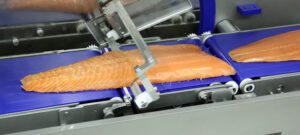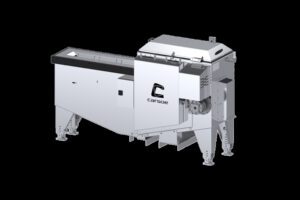
In recent years, the rise in the consumption of seafood by consumers in North America and around the world has raised the demand for fish-based products and processed fish. Consequently, at least in part, the demand for fish processing equipment has been on the rise, according to recent market studies.
The processing equipment market is anticipated to see a compound annual growth rate (CAGR) of 3.9% between 2023 and 2033, according to a report released in mid-August by Delaware-based research firm Future Marketing Insights.
The market currently holds a valuation of just over $308 million, and is forecast to cross $451.6 million in 10 years, according to the report. Among the reasons cited for the projected rise:
Government support to small businesses in some locales via subsidies to help businesses launch fish-processing units.
An increase in molding fish products from traditional shapes like fillets into various forms, such as balls, sticks, nuggets, cakes and pastes.
Vendors have begun producing equipment for specific seafood items in order to segregate the fish and prevent the mixture of different types.
Increased demand for tuna, shrimp and other canned products that are put through processing units.
The leading segment in catch processing, based on the production type, is slaughtering and gutting equipment. Projections say it is likely to thrive at a CAGR of 3.5% over the next 10 years, since it’s used the most in processing units, along with being the part of processing equipment that’s physically unattached to the main unit.
The biggest segment based on the end-user category is seafood processors, forecast to thrive at a CAGR of 3.7% between 2023 and 2033. The high growth rate is attributed to its diversified client base along with the strong supply chain.
Many companies that make and sell processor equipment are headquartered in such Arctic nations as Norway (Optimar), Iceland (Valka, Marel, Martak) and Denmark (BoaTek, Carsoe) as well as Germany (BAADER).
However, the U.S. is anticipated to hold the biggest market share—$89 million—by 2033, with a CAGR of 2.9% due to expected higher consumption of processed food.
Additionally, the market for fish processing equipment in such Asian countries as China, Japan and South Korea has strengthened over the years. These countries are likely to rise to the same high 3.8% CAGR during the forecast period, according to projections.
The growth is attributed to the expanding seafood industry along with new cuisines coming into play due to globalization.
One thing of note—Future Marketing Insights pointed out that “environmental risks and (the) vegan movement” have slowed down the demand for processed fish.
Here are some other noteworthy developments in the processing equipment industry over the past several months.

New Marel Equipment
In the first quarter of 2023, Marel announced two new pieces of fish processing equipment: the MSC 55 MA multi-angle fish slicer and the MS 2750 salmon filleter.
The MSC 55 MA, which was introduced in January, covers slicing needs for those seeking a basic slicer for daily cutting of fresh smoked salmon, raw salmon and similar species into slices between two and 60 millimeters.
Operators can set the cutting angle between 10-degree and 70-degree angles to produce various products, such as standard D-cut slices, buffet cut, sashimi, hot smoked portions and raw salmon Karimi portions.
The MS 2750, which was announced in February, “maximizes yield and brings security to daily operations,” according to Marel.

The newest filleting machine in the Marel portfolio is said to be able to provide processors with high-yield filleting for salmon and trout weighing between 1.5 and 10 kilograms. Also, using only 15 liters per minute, the MS 2750 can save up to 2.5 million liters of water annually compared to the competition, Marel has said.
The MS 2750 follows in the footsteps of the company’s MS 2730 filleting machine, can connect with Marel’s Automatic Deheader MS 2721V or the company’s PaceInfeeder pace-setting device to process up to 25 fish per minute without operator input, thereby reducing dependence on manual labor and improving yield, according to Marel.
Processors can choose optional tools for trimming fish back and belly to reduce manual trimming and increase yield even further. In addition, Marel’s cloud-based digital platform called SmartBase is included with the MS 2750.
SmartBase gives processors access to real-time data on machine health and performance, allowing operators to make data-driven decisions that Marel has said can increase uptime and machine efficiency, thereby reducing energy consumption and optimizing processing lines.
“The SmartBase dashboard enables processors to easily see and resolve problems before they occur,” Marel said in a statement. “With more efficient service options, processors reduce the risk of downtime.”

Carsoe Gutting Machine
In late February, Carsoe introduced its KM Mark 7 device, the latest in a series of machines that automate the fish-gutting process onboard vessels and in land-based fish factories. The Mark 7, according to Carsoe, ensures a higher capacity in less time than previous models, as well as improved gutting.
The capacity of KM Mark 7 is up to 60 fish per minute depending on fish size and the operator’s preferred feeding speed, according to the company.
“Compared to manual fish gutting, this capacity is at a level of up to five operators’ work effort,” Carsoe explained in a statement. “Also, this model has up to 50% higher capacity than our previous model, KM Mark 5.”
One of the key features of the latest model is a one-side-service construction where all maintenance can be carried out from one side of the machine.
“This design is highly space saving on deck, as machines can be installed right up to the bulkhead or two machines side by side,” the company said.
In addition, KM Mark 7 allows users to adjust gutting length while the machine is in operation, providing them with a continuous workflow.
“You can use the machine as stand-alone equipment or as part of a turnkey seafood processing solution,” Carsoe remarked. “To optimize your production outcome even further, you add a fish elevator in the line before the fish-gutting machine, and a fish washer or fish-cooling carousel after to secure a high-level cleaning of the fish before further processing.”
The gutting machine, which is widely sold throughout the world, is highly useful for gutting a long line of whitefish, the company said, including cod, saithe, hake, haddock, whiting, Alaska pollock, red cod, blue cod, southern hake, merluza, southern blue whiting and hoki.
BAADER + EMYDEX
In July, BAADER took a majority stake in EMYDEX Technology, an Ireland-based firm that develops and distributes software for food-processing companies. In a news release, BAADER said that it was “pioneering digital transformation in the food-processing sector.”
The German company also said that the move not only amplifies the digital expertise of BAADER, but also fuels EMYDEX’s expansion and market penetration.
Founded in 2004, EMYDEX delivers software that tackles the challenges of process management in the food industry. Its software is currently implemented in food-processing facilities across Canada, New Zealand, Australia and southern Africa.
BAADER has said that it plans to incorporate its digitalization division across all food processing sectors. Conversely, EMYDEX’s international expansion plans are being enhanced by BAADER’s market penetration and global reach.
“This strategic alliance,” BAADER said in a news release, “will enable both companies to deliver expanded and synergistic product offerings to their customers.”
“BAADER, with its similar culture and ethos, as well as the access it provides to new markets, was the perfect partner to propel EMYDEX into the next phase of its journey,” EMYDEX CEO David McMahon said.
